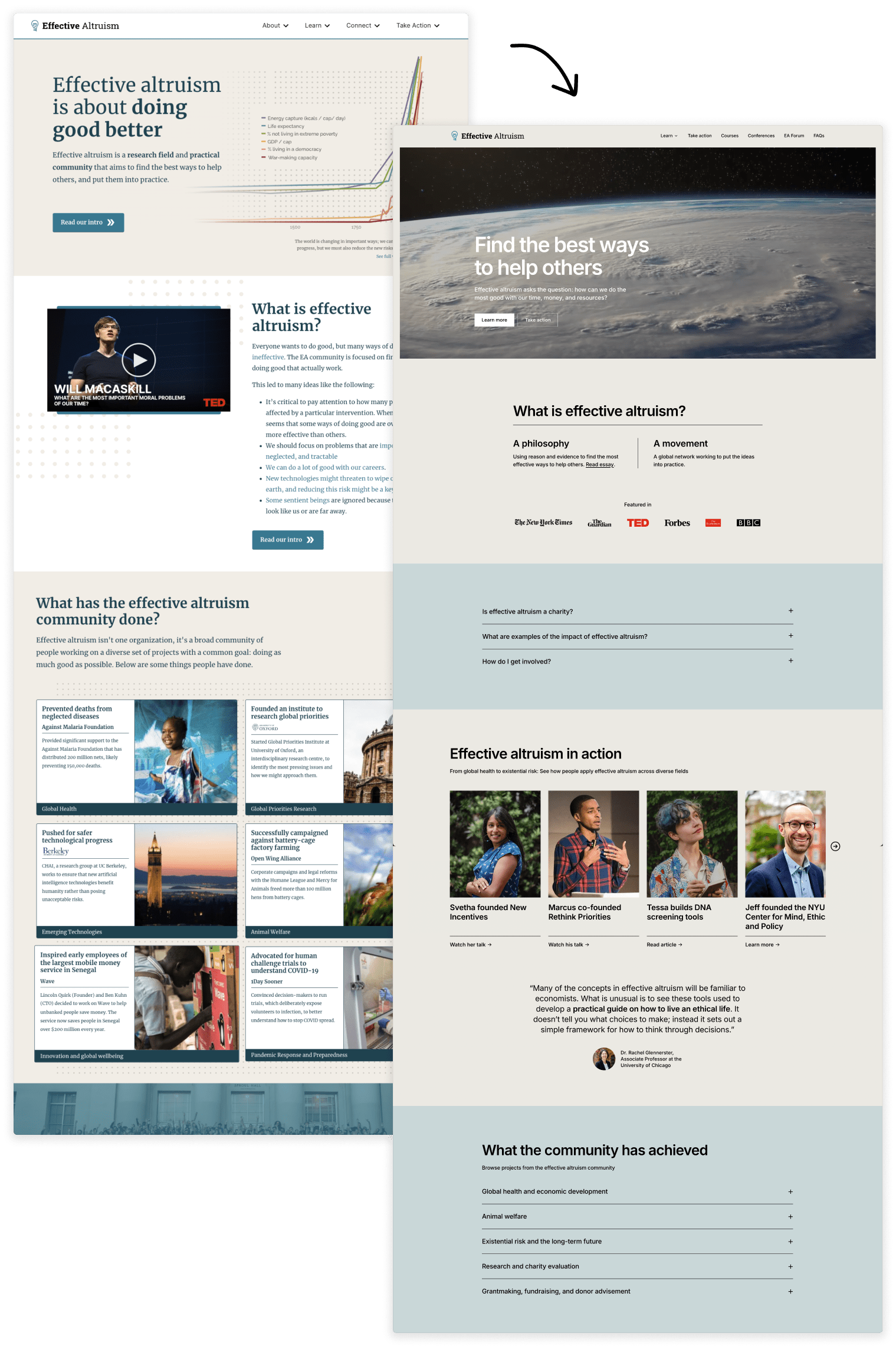We’ve redesigned effectivealtruism.org to improve understanding and perception of effective altruism, and make it easier to take action.
View the new site →I led the redesign and will be writing in the first person here, but many others contributed research, feedback, writing, editing, and development. I’d love to hear what you think, here is a feedback form.

Redesign goals
This redesign is part of CEA’s broader efforts to improve how effective altruism is understood and perceived. I focused on goals aligned with CEA’s branding and growth strategy:
- Improve understanding of what effective altruism is
Make the core ideas easier to grasp by simplifying language, addressing common misconceptions, and showcasing more real-world examples of people and projects. - Improve the perception of effective altruism
I worked from a set of brand associations defined by the group working on the EA brand project[1]. These are words we want people to associate with effective altruism more strongly—like compassionate, competent, and action-oriented. - Increase impactful actions
Make it easier for visitors to take meaningful next steps, like signing up for the newsletter or intro course, exploring career opportunities, or donating.
We focused especially on three key audiences:
- To-be direct workers: young people and professionals who might explore impactful career paths
- Opinion shapers and people in power: journalists, policymakers, and senior professionals in relevant fields
- Donors: from large funders to smaller individual givers and peer foundations
Before and after
The changes across the site are aimed at making it clearer, more skimmable, and easier to navigate. Here are some side-by-side comparisons:
Landing page

Some of the changes:
- Replaced the economic growth graph with a short video highlighting different cause areas and effective altruism in action
- Updated tagline to "Find the best ways to help others" based on testing by Rethink Priorities (interestingly, "Doing good better" performed the worst)
- Chose nouns that resonate more when describing effective altruism ("philosophy" and "movement" vs. "research field" and "practical community"). Also based on the testing done together with Rethink Priorities
- Added more real-world examples of people and organisations working on EA-aligned projects
- Surfaced common questions that new people often have
- Optimised for skimmability (people spend on average ~1 min on the landing page)
- Added a section to take action
…and lots of smaller improvements throughout.
Site navigation
The old navigation came up frequently in user testing. People kept clicking around without finding what they were looking for, and few people ended up interacting with the links in the dropdown. I've significantly simplified it and moved away from using abstract words like "About" and "Connect" to instead naming concrete things like conferences, courses, and FAQs.

New "Take action" page
Previously, users were sent to this page on the Forum. Now common next steps are in one place, and the page is already seeing a lot of interaction.

Early results
To evaluate the redesign I ran surveys and user interviews on the old site, and am now running the same tests on the new site. We'll also run a few different A/B tests in the next couple of months.
It’s still early, but some promising signs so far:
- The "Take Action" page is getting good engagement, where people are mostly interacting with links related to donations and career
- More people than before continue on to the EA Forum, EA Global, and reading FAQs
I’m planning to write a follow-up when we have more data.
Share your thoughts
I'd love to hear your thoughts in the feedback form or as a comment on this post. I'm out of office for the next couple of weeks so may not be able to respond personally, but I'll read every comment!
- ^
The process for identifying the brand associations started with compiling input from a few sources, including external research, a stakeholder survey that received 28 responses and a survey by the communications firm And-Now in 2023 with 689 respondents from EA newsletter subscribers, 26 respondents from CEA staff, and 16 respondents from key external stakeholders. The group working on the EA brand identified the top associations across our target audiences and iterated on the desired associations individually and through group discussion.




Very nice work, I'm excited about this new communications effort! (Minor point: Isn't there an important book missing under resources?)